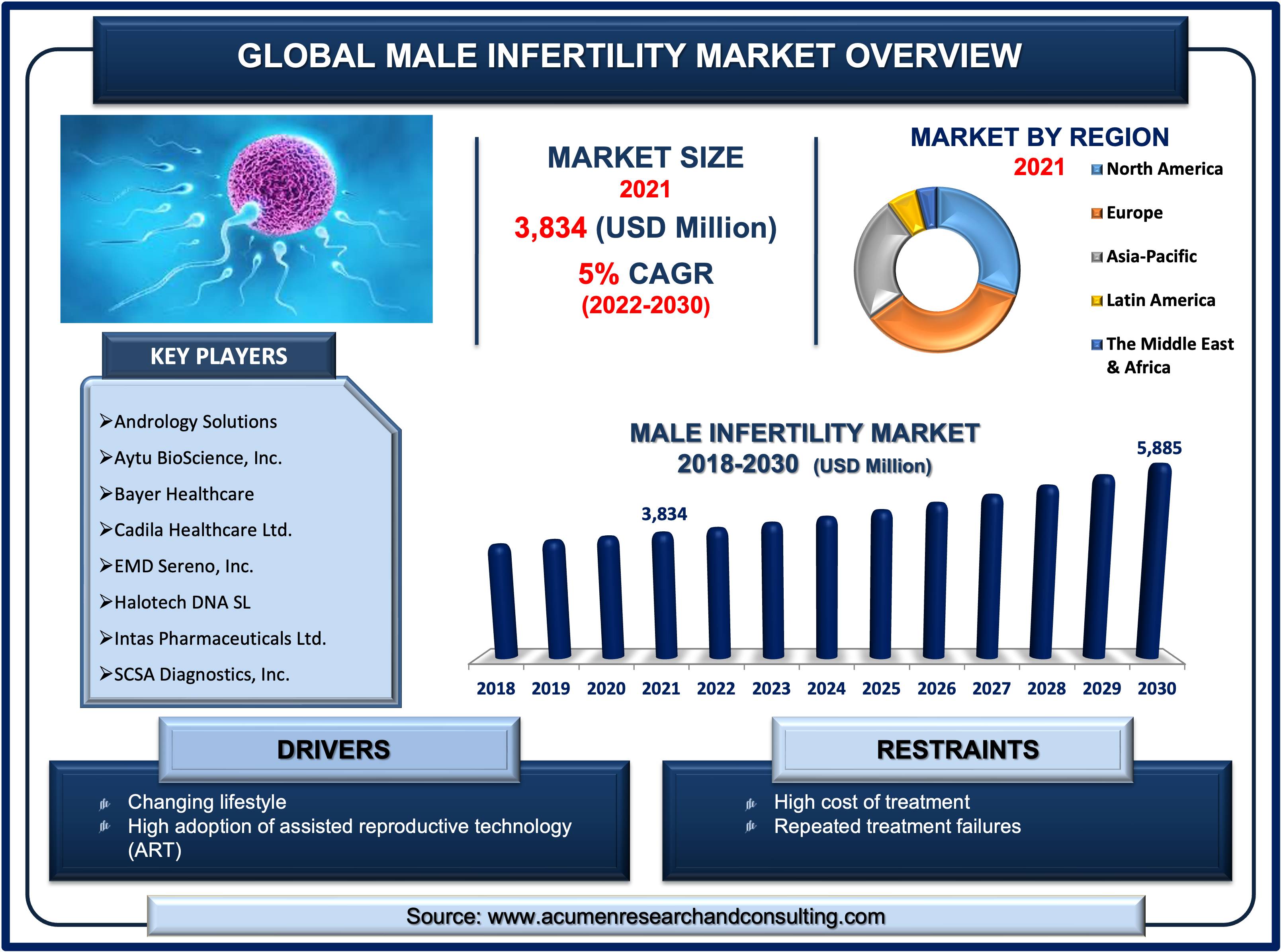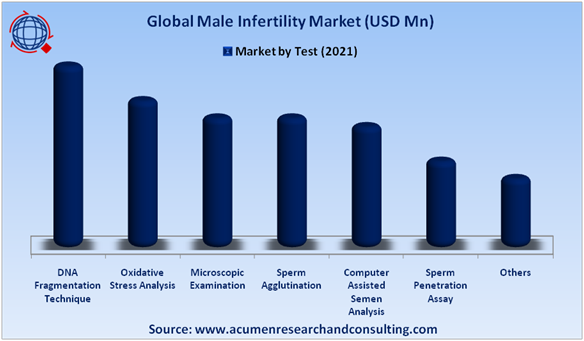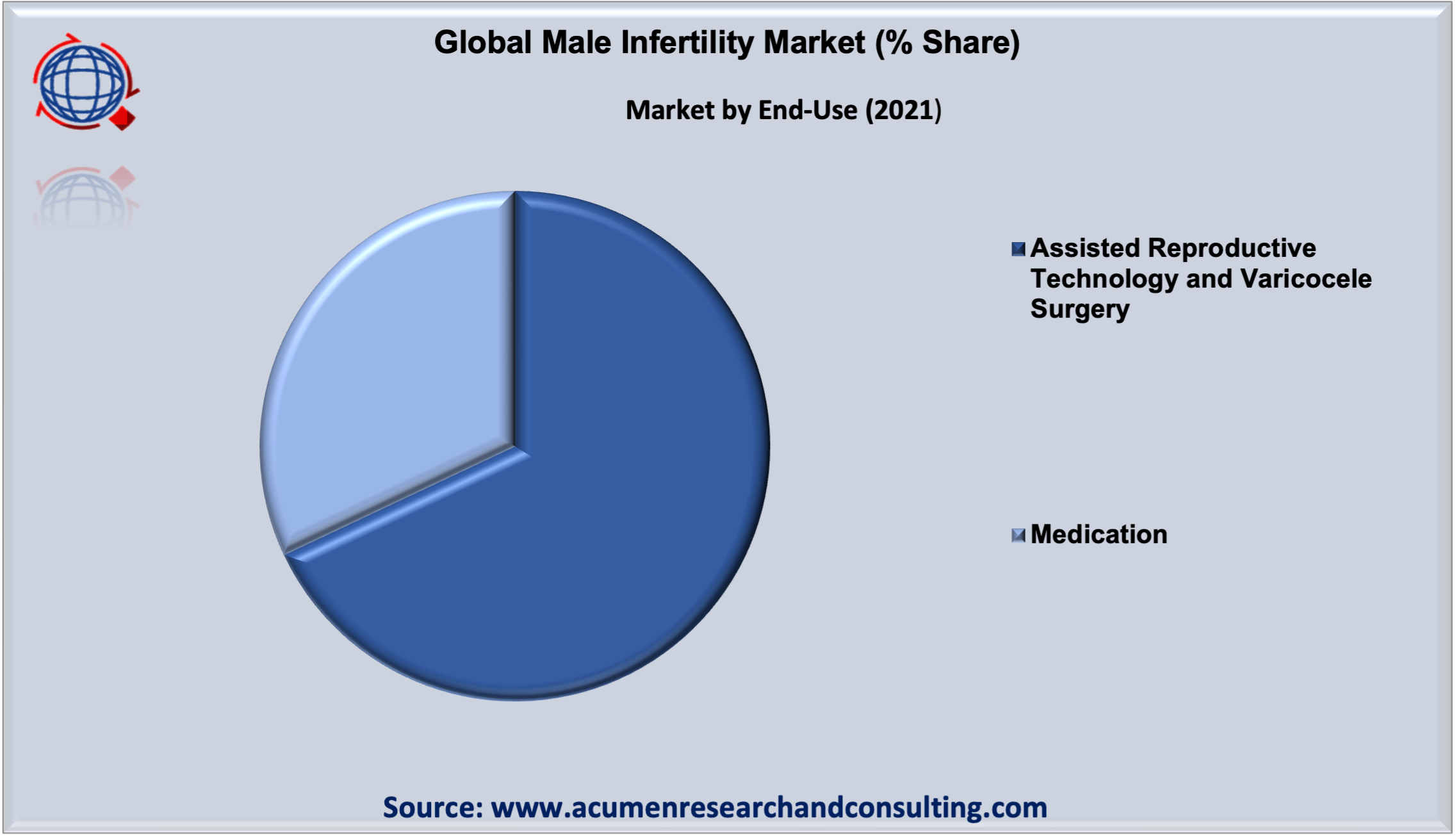Male Infertility Market | Acumen Research and Consulting
Male Infertility Market
Published :
Report ID:
Pages :
Format : ![]()
The Global Male Infertility Market size accounted for US$ 3,834 Mn in 2021 and is estimated to reach US$ 5,885 Mn by 2030, with a significant CAGR of 5.0% from 2022 to 2030.
Male infertility is a significant problem in today's society. Infertility has historically been regarded to be a female issue. However, males are responsible for infertility almost half of the time. The issue often stems from the process of either making or moving sperm, which can be caused by a variety of factors such as varicocele, genetic abnormalities, hormonal disorders, an undescended testicle, and the use of anabolic steroids or anti-seizure medications. Another important issue is getting the sperm to where it has to go. Men with this type of infertility have normal sperm counts in their testicles, but their sperm count in their sperm is either abnormal, very low, or non-existent. Retrograde ejaculation, blockage, anti-sperm antibodies, and the absence of the main sperm pipeline known as the vas deferens induce this form of infertility. According to estimates, idiopathic infertility affects more than 25% of infertile males. That means they have low or aberrant sperm counts for no apparent cause. Male fertility market revenue is been generating progressively due to the advancement in fertility treatment.

Market Growth Drivers:
- Changing lifestyle
- High adoption of assisted reproductive technology (ART)
- Increasing awareness among the people
Market Restraints:
- High cost of treatment
- Repeated treatment failures
Market Opportunities:
- Advancement in infertility treatments
- Growing healthcare infrastructure
Report Coverage
| Market | Male Infertility Market |
| Market Size 2021 | US$ 3,834 Mn |
| Market Forecast 2030 | US$ 5,885 Mn |
| CAGR | 5.0% During 2022 - 2030 |
| Analysis Period | 2018 - 2030 |
| Base Year | 2021 |
| Forecast Data | 2022 - 2030 |
| Segments Covered | By Test, By Treatment, By End-User, And By Geography |
| Regional Scope | North America, Europe, Asia Pacific, Latin America, and Middle East & Africa |
| Key Companies Profiled | Andrology Solutions, Halotech DNA SL, AytuBioScience, Inc., Bayer Healthcare, EMD Sereno, Inc., Cadila Healthcare Ltd., SCSA Diagnostics, Inc., and Intas Pharmaceuticals Ltd. |
| Report Coverage |
Market Trends, Drivers, Restraints, Competitive Analysis, Player Profiling, Regulation Analysis |
| Customization Scope |
10 hrs of free customization and expert consultation |
Male Infertility Market Dynamics
Male infertility is typically caused by spermatogenesis issues. This can be related to poor testicular function, hormonal issues, or blockages in the male urogenital system. Male fertility can arise for a variety of reasons, including both reversible and irreversible diseases. Changing lifestyle is one of the important trends in male infertility market that is supporting the industry growth. Alcohol and tobacco usage, as well as participation in high-intensity sports or activities that may expose testicles to high temperatures(like saunas or occupational exposures), can all contribute to infertility. In addition to that, other factors that are responsible for male infertility are overweight or obesity, age more than 40, exposure to radiation, azoospermia, oligospermia, malformed sperm, cancer treatments, etc.
Assisted reproductive techniques (ARTs) are one of the treatment techniques that are on a boom due to the rising cases of male infertility. ARTs are high-tech ways for joining sperm and egg when intercourse fails. Intrauterine insemination (IUI), in vitro fertilization (IVF), intracytoplasmic sperm injection (ICSI), and sperm retrieval for ART are some of the most used assisted reproductive technologies.
Growing awareness among male infertility treatments are expected to boost the demand throughout the forecast period 2022 – 2030. Regions such as North America and Europe have a larger portion of the male infertility market because of the increased awareness in their countries. Male infertility cases are seldom reported in underdeveloped countries due to social stigma and cultural fears, despite the fact that the number of instances is considerable in these countries. Furthermore, continuous R&D efforts are made to have a deeper knowledge of the idiopathic realm of infertility. As a result, corporations are investing in the development of equipment for determining the fundamental cause and providing focused treatment.
Male Infertility Market Segmentation
The global male infertility market is segmented based on test, treatment, end-user, and geography.
Market by Test
· Oxidative Stress Analysis
· DNA Fragmentation Technique
· Microscopic Examination
· Sperm Agglutination
· Computer Assisted Semen Analysis
· Sperm Penetration Assay
· Others

Based on our analysis, the DNA fragmentation technique segment achieved a considerable amount of male infertility market share in 2021. Sperm DNA fragmentation tests evaluate the quality of the DNA package that contains the offspring's critical genetic information. As a result, the tests are unique and more significant than traditional sperm parameters. Sperm chromatin structure assay (SCSA), single-cell gel electrophoresis (Comet) assay, terminal transferase dUTP nick end labeling (TUNEL) assay and sperm chromatin dispersion (SCD or Halo) test are the most often utilized tests. These tests evaluate different aspects of DNA damage and have varying sensitivity.
Market by Treatment
- Medication
- Assisted Reproductive Technology and Varicocele Surgery
Out of these, the assisted reproductive technology and varicocele surgery segment held the largest male infertility market share in 2021 as these procedures are mostly preferred for men. In addition to that, male infertility is treated with ARTs due to main causes such as sperm autoantibodies, epididymal malfunction, viral orchitis, chemotherapy, heat, accessory gland infection, trauma, and other idiopathic variables. On the other hand, varicoceles are enlarged scrotal veins. They are discovered in 16 out of every 100 men. They are more prevalent in infertile guys (40 out of 100). Varicoceles can be corrected with a modest outpatient procedure known as varicocelectomy. Repairing enlarged veins improves sperm mobility, quantity, and shape.
Market by End-User
- Hospitals and Clinics
- Fertility Centers
- Research Institutes
- Others

Among them, the fertility centers segment held for the maximum market share during the forecasted timeframe from 2022 to 2030. Fertility centers have dedicated healthcare professionals that treat males with persice medication. Furthermore, this segment is also anticipated to attian the fastest growth rate throughout the forecast period. Growing number of fertility centers across the world is also expected to support the industry growth.
Male Infertility Market Regional Overview
North America
· U.S.
· Canada
Europe
· U.K.
· Germany
· France
· Spain
· Rest of Europe
Latin America
· Mexico
· Brazil
· Rest of Latin America
Asia-Pacific
· India
· Japan
· China
· Australia
· South Korea
· Rest of Asia-Pacific
The Middle East & Africa (MEA)
· Gulf Cooperation Council (GCC)
· South Africa
· Rest of the Middle East & Africa
Better Coverage for Diagnosis and Treatment Boosts the Europe Male Infertility Market Revenue
North America, Latin America, Asia-Pacific, Europe, and the Middle East and Africa are the regional segments (MEA). Europe will account for a substantial portion of revenue in 2021 because of the availability of advanced fertility facilities, a high level of knowledge, and higher acceptance of more expensive therapy. North America generated the second largest market share due to an increase in male infertility caused by lifestyle variables such as obesity and diet, as well as technology breakthroughs that are meeting the need for treatment. Meanwhile, the Asia-Pacific area is predicted to grow at the quickest rate in the next years. The expanding elderly population, combined with an increase in lifestyle-related disorders, has led in an increase in male infertility.
Competitive Landscape
Some of the top vendors offered in the professional report include Andrology solutions, Halotech DNA SL, AytuBioScience, Inc., Bayer Healthcare, EMD Sereno, Inc., Cadila Healthcare Ltd., SCSA Diagnostics, Inc., and Intas Pharmaceuticals Ltd.
Frequently Asked Questions
How much was the estimated value of the global male infertility market in 2021?
The estimated value of global male infertility market in 2021 was accounted to be US$ 3,834 Mn.
What will be the projected CAGR for global male infertility market during forecast period of 2022 to 2030?
The projected CAGR of male infertility market during the analysis period of 2022 to 2030 is 5.0%.
Which are the prominent competitors operating in the market?
The prominent players of the global male infertility market involve Andrology solutions, Halotech DNA SL, AytuBioScience, Inc., Bayer Healthcare, EMD Sereno, Inc., Cadila Healthcare Ltd., SCSA Diagnostics, Inc., and Intas Pharmaceuticals Ltd.
Which region held the dominating position in the global male infertility market?
Europe held the dominating share for male infertility during the analysis period of 2022 to 2030.
Which region exhibited the fastest growing CAGR for the forecast period of 2022 to 2030?
Asia-Pacific region exhibited fastest growing CAGR for male infertility during the analysis period of 2022 to 2030.
What are the current trends and dynamics in the global male infertility market?
Changing lifestyle, high adoption of assisted reproductive technology (ART), and increasing awareness among the people all contribute to the expansion of the worldwide male infertility market.
By segment test, which sub-segment held the maximum share?
Based on test, DNA fragmentation technique segment held the maximum share for male infertility market in 2021.


